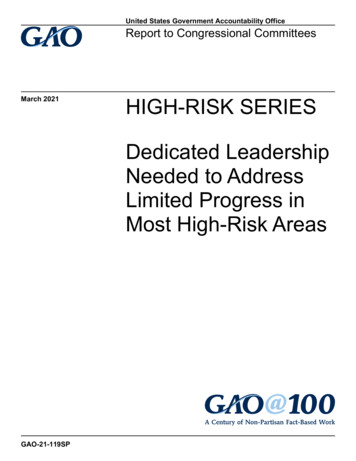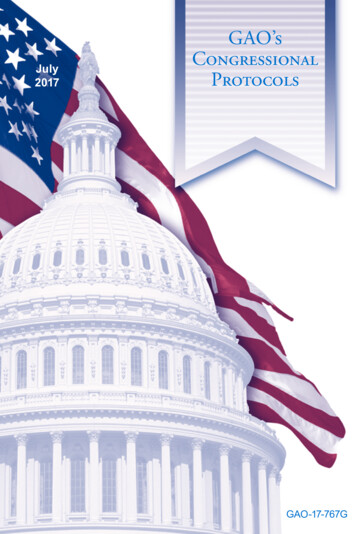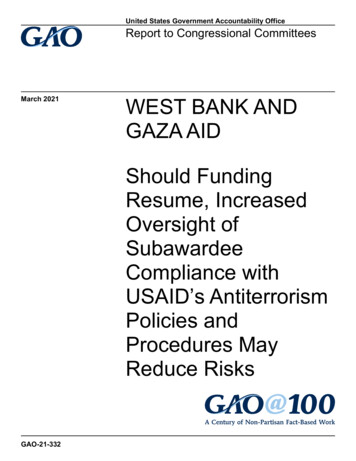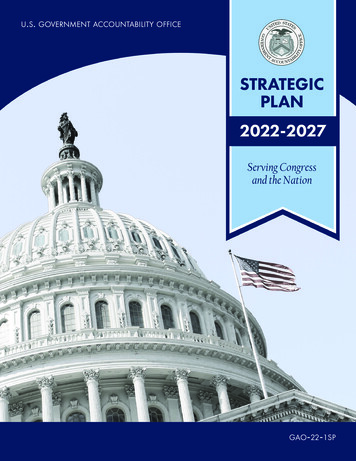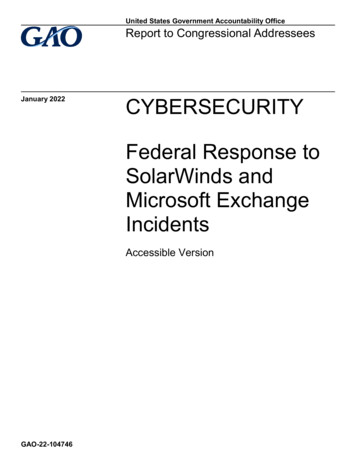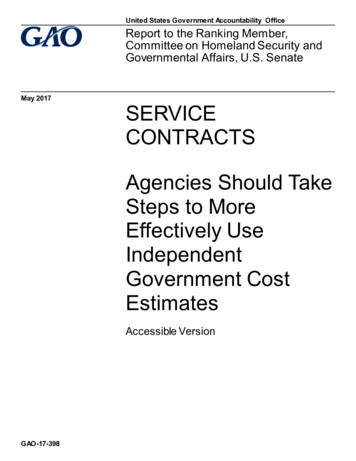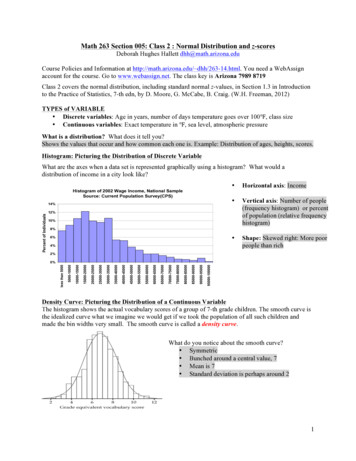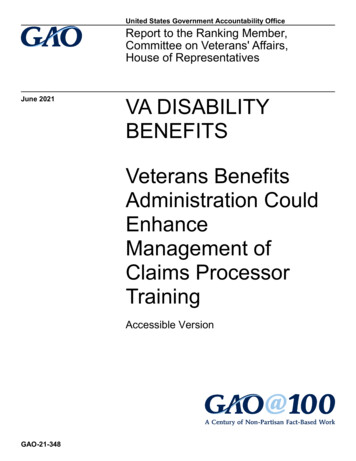
Transcription
United States Government Accountability OfficeReport to the Ranking Member,Committee on Veterans' Affairs,House of RepresentativesJune 2021VA DISABILITYBENEFITSVeterans BenefitsAdministration CouldEnhanceManagement ofClaims ProcessorTrainingAccessible VersionGAO-21-348
GAO HighlightsJune 2021VA DISABILITY BENEFITSHighlights of GAO-21-348, a report to theRanking Member, Committee on Veterans’Affairs, House of RepresentativesVeterans Benefits Administration Could EnhanceManagement of Claims Processor TrainingWhy GAO Did This StudyWhat GAO FoundIn fiscal year 2019, VBA processedover 1.4 million claims for disabilitycompensation and provided about 88billion in benefits to veterans injured inservice to their country. Claimsprocessors receive training to helpthem determine veterans’ eligibility forthese benefits.The Veterans Benefits Administration (VBA) has over 9,000 employees whoprocess veterans’ claims for disability compensation. To ensure claimsprocessors have the skills needed to handle disability claims efficiently andeffectively, training is a key strategy. Training is particularly important as VBAhires more staff and implements new initiatives.GAO was asked to review VBA’smanagement of training for disabilityclaims processors. This reportexamines the extent to which VBAapplied relevant leading practicesidentified by GAO for planning,designing, implementing, andevaluating training, among otherobjectives.GAO reviewed relevant federal laws,regulations, policies, and trainingmaterials; assessed VBA’s effortsagainst relevant leading practices fortraining in the federal government; andinterviewed officials from VBAheadquarters and managers andclaims processors at four regionaloffices, selected for variation on officesize, region, and claims workload.GAO assessed VBA’s training program for disability claims processors againstleading practices for training related to planning, design, implementation, andevaluation. GAO found that VBA partially applied these leading practices.·Planning. VBA’s planning included some efforts to determine the skills andcompetencies needed for a trained workforce to process claims, consistentwith leading practices. However, it lacks an integrated and comprehensiveplan to ensure training improves individual and agency performance.Specifically, VBA’s planning has not been guided by training program goalsor a governance structure that sets priorities with a strategic focus on howefforts will contribute to results. Instead, VBA has used a project-by-projectplanning approach.·Design. In designing its training program, VBA has used a variety of trainingdelivery mechanisms, consistent with leading practices. For example,mechanisms include self-paced and instructor-led classroom training andsoftware to manage and deliver training. However, VBA lacks criteria toinform its selection of the most appropriate mechanism to deliver eachcourse.·Implementation. Regional offices and VBA headquarters work together todeliver training, per leading practices. However, VBA’s policies to monitor theextent to which claims processors have received required training areincomplete. Specifically, it lacks policies requiring VBA to identify and correctdeficiencies in completing annual training for experienced claims processors.·Evaluation. VBA collects and incorporates some stakeholder feedbackabout training and recently finalized plans to evaluate certain training,consistent with leading practices. However, VBA’s efforts do not include keystakeholder perspectives, such as those of experienced staff and theirsupervisors, and VBA does not have policies to ensure evaluations areconsistently planned and conducted. GAO’s prior work indicates thatevaluation has been a consistent gap in VBA’s management of training.What GAO RecommendsGAO is making 10 recommendations,including that VBA establish anintegrated and comprehensive planand performance goals for its trainingprogram; document and use criteria toinform its selection of training deliverymechanisms; develop policies tomonitor compliance with requiredtraining; collect and incorporatestakeholder feedback; and evaluatetraining on a recurring basis. VAgenerally concurred with GAO’srecommendations.View GAO-21-348. For more information,contact Elizabeth H. Curda at (202) 512-7215or curdae@gao.gov.VBA officials described several challenges to fully applying leading practices forplanning, such as other higher priorities and the frequency with which the agencyis tasked with urgent or emerging training needs. VBA also stated that it hassome specific strategies in place to guide training efforts, such as setting annualtraining requirements. Nevertheless, fully applying leading practices for trainingwould provide VBA greater assurance that its workforce is sufficiently skilled toefficiently and effectively process disability claims and provides high-qualityservice to veterans.United States Government Accountability Office
ContentsGAO HighlightsiWhy GAO Did This StudyWhat GAO RecommendsWhat GAO Found1111LetterBackgroundVBA’s Planning and Process for Designing Training PartiallyApplied Leading Practices for TrainingVBA’s Efforts to Implement and Evaluate Training Do Not FullyApply Leading Practices for TrainingVBA Generally Applied Selected Leading Practices to Blue WaterNavy Training, but Did Not Plan to Collect and Share LessonsLearnedConclusionsRecommendations for Executive ActionAgency Comments and Our EvaluationAppendix I: Selection of Relevant Leading Practices for Assessing Training58173238394043Appendix II: Comments from the Department of Veterans Affairs47Text of Appendix II: Comments from the Department of VeteransAffairsAppendix III: GAO Contact and Staff Acknowledgments5156TablesText of Figure 1: Veterans Benefits Administration Offices withResponsibility for Training of Disability Claims ProcessorsTable 1: Blue Water Navy (BWN) Training Courses by Role,Delivery Mode, and LengthTable 2: GAO Assessment of VBA Claims Processor Trainingagainst Relevant Leading Practices for TrainingTable 3: GAO Assessment of Blue Water Navy Training Effortsagainst Relevant Leading Practices for TrainingPage i12344345GAO-21-348 VA Disability Benefits
FiguresFigure 1: Veterans Benefits Administration Offices withResponsibility for Training of Disability Claims Processors11AbbreviationsCOVID-19Coronavirus Disease 2019OFOOffice of Field OperationsOTMOffice of Talent ManagementRVSRRating Veterans Service RepresentativeTMPIOffice of Talent Management, Training Managementand Performance Improvement DivisionTMSTalent Management SystemVADepartment of Veterans AffairsVASRDVeterans Affairs Schedule for Rating DisabilitiesVBAVeterans Benefits AdministrationVSRVeterans Service RepresentativeThis is a work of the U.S. government and is not subject to copyright protection in theUnited States. The published product may be reproduced and distributed in its entiretywithout further permission from GAO. However, because this work may containcopyrighted images or other material, permission from the copyright holder may benecessary if you wish to reproduce this material separately.Page iiGAO-21-348 VA Disability Benefits
441 G St. N.W.Washington, DC 20548LetterJune 7, 2021The Honorable Mike BostRanking MemberCommittee on Veterans’ AffairsHouse of RepresentativesDear Mr. Bost:The Department of Veterans Affairs’ (VA) Veterans BenefitsAdministration (VBA) provides annual training to more than 9,000 claimsprocessors across its 56 regional offices to help ensure claims processorsare making quality decisions on veterans’ claims for disabilitycompensation benefits. In fiscal year 2019, VBA processed more than 1.4million claims for disability compensation and provided about 88 billion inbenefits to veterans injured in service to their country.VBA’s claims processors use relevant regulations and processes todetermine veterans’ eligibility for these benefits. Effective training is a keystrategy to ensure claims processors have the skills needed to processdisability claims efficiently and effectively, and ultimately provide highquality service to veterans.1 This training is particularly important sinceVBA continues to implement new initiatives and make changes to claimsprocessing procedures while hiring more staff. Moreover, in January2020, the agency began processing thousands of additional disabilityclaims related to exposure to herbicides during the Vietnam War due tothe enactment of the Blue Water Navy Vietnam Veterans Act of 2019.2VBA’s capacity to address claims is also being hindered by surges inother workloads, such as by the Coronavirus Disease 2019 (COVID-19)pandemic-related slowdowns in medical exams and hearings. Thedisability compensation program has long-standing challenges inmanaging large workloads and making timely decisions on initial and1Althoughtraining is a key human capital strategy available to agency leaders to achievegoals and enhance performance, not every situation calls for additional training. Barriersto performance could relate to obsolete technology, for example, rather than a lack ofknowledge or skills.2Amongother things, the Blue Water Navy Vietnam Veterans Act of 2019 extended thepresumption of service connection for disability compensation for certain illnessesassociated with exposure to herbicides, such as Agent Orange, to veterans who served inthe offshore waters of the Republic of Vietnam during the Vietnam War. Pub. L. No. 11623, § 2(a), 133 Stat. 966, 966-967.Page 1GAO-21-348 VA Disability Benefits
Letterappealed claims. The program was added to GAO’s High-Risk List in2003.3Our prior work has identified leading practices to help federal agenciesimprove their strategic training efforts by assessing how they plan,design, implement, and evaluate effective training programs.4 In priorreviews, we had assessed VBA’s training for claims processors againstleading practices for training, and had identified issues with monitoringtraining completion, evaluating training effectiveness, and usingfeedback.5You asked us to review VBA’s management of its training for disabilityclaims processors.6 This report examines the extent to which VBA appliedrelevant leading practices for: (1) planning and designing training fordisability claims processors; (2) implementing and evaluating training fordisability claims processors; and (3) processing Blue Water Navydisability (BWN) claims.For all three objectives, we reviewed relevant federal laws, VBA policydocuments, reports and planning documents related to aspects of the3VA’sdisability compensation program has long-standing management challenges. Thesechallenges are included on our high-risk list that shows the government operations mostvulnerable to fraud, waste, abuse, or mismanagement, or in need of transformation. Onehigh-risk area is improving and modernizing VA disability programs, including managingclaims workloads and updating VA’s eligibility criteria. See GAO, High-Risk Series:Dedicated Leadership Needed to Address Limited Progress in Most High-Risk Areas,GAO-21-119SP (Washington, D.C.: Mar. 2, 2021), 267.4GAO,Human Capital: A Guide for Assessing Strategic Training and Development Effortsin the Federal Government, GAO-04-546G (Washington, D.C.: Mar. 1, 2004). In thisreport, we identified leading practices through consultations with government officials andexperts in the private sector, academia, and nonprofit organizations; examinations ofrelevant federal laws and regulations related to training and development in the federalgovernment; and reviewing the sizeable body of literature on training and developmentissues, including previous GAO products on a range of human capital topics.5See,for example GAO, Veterans’ Benefits: Increased Focus on Evaluation andAccountability Would Enhance Training and Performance Management for ClaimsProcessors, GAO-08-561 (Washington, D.C.: May 27, 2008).6Throughoutthis report, we use the terms “disability claims processors” and “claimsprocessors” interchangeably.Page 2GAO-21-348 VA Disability Benefits
Lettertraining program.7 We also interviewed agency officials from VBA officeswith responsibilities for claims processor training in headquarters and thefield. We then compared VBA’s efforts—as described in documentationand interviews—to leading practices identified in our 2004 guide forassessing federal government training efforts, as well as relevant federalregulations, and VBA’s training policies.8 Our guide outlines four broad,interrelated components—(1) planning and front-end analysis, (2) designand development, (3) implementation, and (4) evaluation—and identifiesleading practices of effective training and development programs thatshould be present in each of the components.9 We assessed VBA’straining against those practices we determined were relevant to the scopeof our review, which looked at VBA’s general program of training for allclaims processors. See appendix I for relevant practices and ourassessment.10 Based on this assessment, the report discusses areas ofstrategic importance to the training process.11 We assessed the extent towhich the agency applied leading practices in each component to itsoverall training processes and BWN training. We used the followingcategories to describe the extent to which the agency applied relevantleading practices:·Generally applied: agency applied most of the relevant leadingpractices.7Thisreview focused on training requirements for claims processors as defined in VBApolicy. We did not review VBA’s claims processing quality review efforts, which may resultin additional refresher training for claims processors. These efforts include the nationalSystematic Technical Accuracy Review (STAR) and regional office quality review teams.For more information, see Department of Veterans Affairs Office of Inspector General, TheSystematic Technical Accuracy Review Program Has Not Adequately Identified andCorrected Claims-Processing Deficiencies, #19-07059-169 (July 22, 2020) andDeficiencies in the Quality Review Team Program, #19-07054-174 (July 22, 2020).8GAO-04-546G.9Forexample, one practice in the design and development component is that agenciestake steps to ensure that training is connected to improving individual and agencyperformance in achieving specific results. Attributes that would indicate the agency’s effortin this area include: a formal training strategy and tracking and other control mechanismsto ensure that all employees receive appropriate training.10Leadingpractices discussed in the report have been edited or paraphrased to improvereadability.11GAO’straining guide describes core characteristics of strategic training, includingstrategic alignment, leadership commitment, stakeholder involvement, accountability, dataquality assurance, and continuous performance improvement. See GAO-04-546G, 78.Page 3GAO-21-348 VA Disability Benefits
Letter·Partially applied: agency applied some of the relevant leadingpractices.·Did not apply: agency did not apply any of the relevant leadingpractices.We selected four VA regional offices for more in-depth review: Boise,Idaho; Cleveland, Ohio; Jackson, Mississippi; and Waco, Texas—selected for variation on office size, VBA district or region, and BWNclaims workload. For each office we obtained documentation on theirprocesses and plans for training, and interviewed regional officeleadership, training managers, and others responsible for the training ofdisability claims processors. We also conducted discussion groupsconsisting of 7 to 8 randomly selected claims processors at each of thefour regional offices. Information obtained from these interviews cannotbe generalized to all regional offices and staff.For objective one on planning and design, we collected and analyzedinformation from VBA officials and relevant documents on the planningand design of disability claims processor training. We also reviewed aselection of training materials. Using course descriptions from VBA’sLearning Catalog and the list of courses required in fiscal year 2020, wegrouped training courses into required, elective (regional office-selected),and training courses for newly hired or promoted claims processors. Wealso randomly selected and reviewed five courses to determine when thetraining was last updated; if training included a mix of theoretical andpractical content; and if the training included specific, measurablelearning objectives.For objective two on implementation and evaluation of training, we alsoassessed the application of VBA’s policies for monitoring claimsprocessors’ compliance with training requirements by reviewing VBAmanagement reports and regional office plans and data. We reviewedfiscal year 2019 and 2020 training progress reports for claims processorsin the four selected regional offices. We assessed the reliability of thesedata by conducting electronic testing, examining data systemdocumentation, and interviewing staff knowledgeable about the data; wedetermined that these data were reliable for our purposes. To assessVBA’s efforts to evaluate whether training efforts contribute to improvedperformance and results, we analyzed planned and completedevaluations of VBA’s training. We also applied relevant federal standardsPage 4GAO-21-348 VA Disability Benefits
Letterfor internal control.12 The control activities component of internal controlwas significant to this objective, including the principle that managementimplement control activities through policies, as well as the principle thatmanagement evaluate and remediate control deficiencies.For objective three on BWN claims, we compared training for processingthese claims against relevant leading practices in the four components forstrategic training. For this analysis, we selected practices that wedetermined were applicable to a targeted, time-limited training effort. Seeappendix I. We also discussed BWN training in our discussion groupswith staff from the Cleveland and Waco regional offices, two of the eightregional offices responsible for processing these claims. We also selectedone BWN training course, and reviewed the course’s materials using thesame criteria described under objective 1. We selected the course onrating BWN claims because of the complexity of aspects of rating theseclaims, such as determining the effective date of benefits.We conducted this performance audit from January 2020 to June 2021 inaccordance with generally accepted government auditing standards.Those standards require that we plan and perform the audit to obtainsufficient, appropriate evidence to provide a reasonable basis for ourfindings and conclusions based on our audit objectives. We believe thatthe evidence obtained provides a reasonable basis for our findings andconclusions based on our audit objectives.BackgroundDisability CompensationVeterans with service-connected disabilities (i.e., injuries or illnessesincurred or aggravated during active duty military service) may receivemonthly VA disability compensation payments according to the severity oftheir disability. The determination of severity is referred to as a disabilityrating, which is awarded in 10 percent increments up to 100 percent. The12GAO,Standards for Internal Control in the Federal Government, GAO-14-704G(Washington, D.C.: Sept. 10, 2014).Page 5GAO-21-348 VA Disability Benefits
Lettermonthly benefit amount is determined by the veteran’s disability ratingand number of dependents, including a spouse.13VBA staff in the Veterans Service Centers of the regional offices processdisability compensation claims. These claims processors includeVeterans Service Representatives (VSR) who gather evidence needed todetermine entitlement and review the amount of the award and authorizepayment, if any, and Rating Veterans Service Representatives (RVSR orrater) who decide entitlement and the rating percentage.14 In fiscal year2020, VA employed about 9,000 claims processors across its 56 regionaloffices. Claims processors determine disability ratings and benefitamounts using the Veterans Affairs Schedule for Rating Disabilities(VASRD) and VBA’s M21-1 Claims Processing Manual.A 2016 study of VBA claims processing showed that veteran claims wereincreasingly becoming complex, which adds to the time it takes toaccurately process them.15 Factors contributing to this complexity includemore medical conditions per disability claim; claims addressing issuesthat require special training for claims processors, such as multiple organdamage; and, claims for issues such as post-traumatic stress disorderand traumatic brain injury. Additionally, VBA expects the disabilitycompensation claims workload to increase as more than one millionservicemembers will depart the military by 2024.Training for VBA Disability Claims ProcessorsVBA’s training program consists of instruction for (1) newly hired orpromoted claims processors, and (2) experienced disability claimsprocessors. Prior to fiscal year 2021, VBA training for newly hired or13Seegenerally 38 U.S.C. § 1101 et seq. As of December 2020, basic monthly paymentswere, for example, about 144 for a veteran with a 10 percent disability rating and nodependents, and about 3,450 for a veteran with a 100 percent disability rating, a spouse,and one child.14Werefer to Veterans Service Representatives and Rating Veterans ServiceRepresentatives collectively as “claims processors” throughout this report.15SeeNational Academy of Public Administration, Veterans Benefits Administration:Review of the Disability Claims and Appeals Process (Washington, D.C.: October 2016)44-45.Page 6GAO-21-348 VA Disability Benefits
Letterpromoted claims processors was called “Challenge training.”16 Thisprogram was an in-residence, technical skills focused training program forclaims processors to effectively and efficiently serve veterans. In 2019,VBA reported delivering Challenge training to almost 1,000 claimsprocessors. For experienced claims processors, VBA requires thecompletion of 40 hours of training annually.VBA’s Compensation Service stated that per federal regulation, it isresponsible for creating agency training programs that support aworkforce capable of achieving agency mission and performance goals,and facilitating continuous improvement of employee and organizationalperformance, according to Compensation Service officials.17Compensation Service sets policy through the M21-3 training programmanual, determines claims processing skills, designs training courses,and oversees the training. Staff in each regional office are responsible foradministering their office’s training program. According to officials, eachregional office typically has a Training Manager who facilitates theregional office training programs, and larger offices may also have aTraining Coordinator who assists the Training Manager.Blue Water Navy Vietnam Veterans Act of 2019In 2020, VBA began processing claims for disability compensation underthe Blue Water Navy Vietnam Veterans Act of 2019. One provision of thislaw extends the presumption of herbicide exposure, such as exposure toAgent Orange,18 to veterans who served in the offshore waters of theRepublic of Vietnam between January 9, 1962 and May 7, 1975.19Another provision of the law extends the presumption of service16Infiscal year 2021, VBA transitioned Challenge Training to Virtual and In-PersonProgression (VIP) training.17See5 C.F.R. § 410.201.18AgentOrange is an herbicide used to clear leaves and vegetation for tactical militaryoperations during the Vietnam War.19SeePage 738 U.S.C. § 1116A(b).GAO-21-348 VA Disability Benefits
Letterconnection to these veterans, if they have certain specified illnesses.20 Asof these provisions’ effective date, January 1, 2020, veterans who meetthis service criteria do not need to prove exposure to an herbicide, nor (ifthey have one of the specified illnesses) do they need to prove that theirillness was incurred or aggravated during active duty military service.Instead, VA presumes that such veterans with a specified illness haveincurred them as a result of exposure to an herbicide during their service,making it easier for the veteran to get disability compensation. If a veteranmeets this service criteria and believes an illness that is not one of thespecified illnesses is related to their military service, they can provideadditional evidence, such as scientific or medical evidence stating that theillness is caused by an herbicide, for consideration with their claim.VA estimated that as many as 560,000 Vietnam-era veterans may beentitled to a presumption of exposure to an herbicide under the BlueWater Navy Vietnam Veterans Act of 2019, and estimated that theagency would receive about 238,000 claims and over 35,000 appeals asa result of this law by 2024.21VBA’s Planning and Process for DesigningTraining Partially Applied Leading Practices forTrainingVBA Has Begun Identifying Skills and Competencies butHas Not Established Performance Goals or Fully AppliedOther Leading Practices to Guide Its Training EffortsVBA’s planning efforts have focused on aligning training with skills andcompetencies and a project-by-project approach; however, it has notdeveloped integrated and comprehensive plans or strategies, including20See38 U.S.C. § 1116A(a). Examples of these illnesses include, in certaincircumstances, respiratory cancers, Non-Hodgkin lymphoma, type II diabetes, andchloracne. The specified illnesses are set forth in federal law. Federal law also requiresthat when VA determines (on the basis of sound medical and scientific evidence) that anassociation exists between an illness and exposure to an herbicide, VA must promulgateregulations providing for a presumption of service connection related to that illness. See38 U.S.C. § 1116.21Departmentof Veterans Affairs, “FY202 1Budget Submission, Volume III: Benefits andBurial Programs and Departmental Administration,” February 2020, page VBA-175;“Expansion of Benefits to Blue Water Navy Vietnam Veterans,”Page 8GAO-21-348 VA Disability Benefits
Letterperformance goals and a governance structure, to guide the trainingprogram, according to leading practices. VBA provided several reasonsfor not fully applying these practices including that it is frequently taskedwith urgent or emerging training needs. Such planning helps to ensurecoordinated, rather than ad hoc efforts to address needs and achieveresults, and serves as a foundation to design, implement, and evaluatetraining in accordance with agency needs and goals. Specifically, leadingpractices that support a strategic approach to training include:·determining necessary skills and competencies;·establishing performance goals;·establishing a governance structure with clear lines of authority orother appropriate accountability mechanism to ensure sufficientattention is paid to planning and to coordinate strategies; and·developing a documented training strategy.22Determining skills and competencies. VBA has some planning effortsunderway to help align training with claims processor skills andcompetencies. For example, VBA has conducted periodic job and taskanalysis for claims processors. According to a VBA official, theseanalyses help ensure they are teaching concepts needed by claimsprocessors. VBA also recently re-started an effort to create acompetency-based training system for claims processors. According toVBA, the agency will determine the necessary skills and competencies forclaims processors, and develop a program of instruction to align withthese competencies, consistent with leading practices. VBA officials toldus the first step in this effort will be completed in October 2021.23Performance goals. In addition, VBA has not established performancegoals for its training program. As we have previously reported,performance goals and measures should indicate how well a program is22GAO-04-546G.23VBAis also updating its agency workforce plans and guidance, which may includeadditional assessment of skills and competencies and strategies to address identifiedgaps. We previously recommended that VBA incorporate key leading practices (such asidentifying strategies to close workforce gaps, including training) into its successionplanning for mission-critical occupations, which includes disability claims processors. As ofApril 2021, this recommendation remains unimplemented (open). See GAO, Departmentof Veterans Affairs: Improved Succession Planning Would Help Address Long-StandingWorkforce Problems, GAO-20-15 (Washington, D.C.: Oct. 10, 2019).Page 9GAO-21-348 VA Disability Benefits
Letterachieving its organizational goals and objectives, and managers shoulduse performance information to continuously improve processes, identifyperformance gaps, and set improvement goals and priorities.24In January 2020, VBA issued its fiscal year 2021-2025 strategic plan thatincludes several broad goals related to VBA training efforts.25 Forexample, the strategic plan includes a goal to assess employee skills andaddress aptitude gaps within the VBA workforce.26 However, VBA officialsacknowledged that the disability claims processor training program doesnot have program-level goals or measures that also support broader VBAgoals, as suggested by the leading practices.27According to Compensation Service officials, they have not establishedprogram-level goals because their focus was on higher-priority tasks. Asa result, Compensation Service’s decisions to prioritize the re-design oftraining for newly hired or promoted claims processors and developmentof a competency-based training system are not guided by goals andassociated performance information. For example, VBA has paused itsskills certification program for claims processors, citing a lack of desiredresults. However, VBA officials did not identify performance measuresused to gauge the performance of this effort. Without establishing a24GAO-04-546G;and GAO, Executive Guide: Effectively Implementing the GovernmentPerformance and Results Ac
Page 1 GAO-21-348 VA Disability Benefits . 441 G St. N.W. Washington, DC 20548. Letter . June 7, 2021 The Honorable Mike Bost Ranking Member Committee on Veterans' Affairs House of Representatives Dear Mr. Bost: The Department of Veterans Affairs' (VA) Veterans Benefits Administration (VBA) provides annual training to more than 9,000 claims

